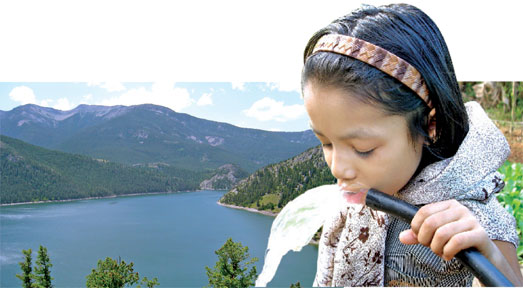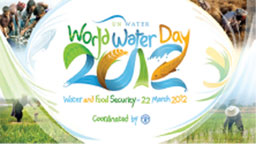|
World Water Day on Thursday:
Water and food security – an inextricable link
By Pramod DE SILVA
Just a few days ago, I received a very interesting Power Point
presentation via email, titled 'A Letter from 2070'. That is just 60
years away, by the way. It was mainly about water, or rather the lack of
it on Earth, circa 2070.
 We
cannot predict whether any of it will come true, but here are just a few
of the gloomy statements from the 'Letter from 2070': Most of the
world’s freshwater has dried up; desertification has intensified; people
are mugged on the streets for water; 80 percent of the food is synthetic
(you will see why later in the article); each person is allowed to drink
only half-a-glass per day; there is extreme dehydration; water is much
more valuable than diamonds, platinum or gold. We
cannot predict whether any of it will come true, but here are just a few
of the gloomy statements from the 'Letter from 2070': Most of the
world’s freshwater has dried up; desertification has intensified; people
are mugged on the streets for water; 80 percent of the food is synthetic
(you will see why later in the article); each person is allowed to drink
only half-a-glass per day; there is extreme dehydration; water is much
more valuable than diamonds, platinum or gold.
As scary as these ‘predictions’ are, there is still time and space to
stop any or all of these from happening. The message is that we should
do more to protect the world’s freshwater reserves since less than one
percent of the total volume of water on Earth is usable for our
consumption and daily needs.
This is the core foundation of the World Water Day, celebrated every
year on March 22 by the United Nations and its Member Countries. It is
held as a means of focusing attention on the importance of freshwater
and advocating the sustainable management of freshwater resources. This
year’s theme is 'Water and Food Security'.
Incidentally, this year marks the 20th anniversary of the Water Day
concept and events will be held worldwide, including in Sri Lanka, to
mark the occasion.
We all need to drink water, which is also essential for personal
hygiene and sanitation. However, water serves an even more important
function: irrigating the world’s crops. From paddy to maize, every crop
cultivated in our planet needs a good supply of water to thrive.
Freshwater reserves
Agriculture accounts for 70 percent of the freshwater reserves, as a
significant amount of water is necessary to produce our food. Just
consider the statistics: There are seven billion people to feed on the
planet today and another two billion are expected to join Planet Earth
by 2050. By 2025, 1.8 billion people will be living in countries or
regions with absolute water scarcity, and two-thirds of the world’s
population could be living under water-stressed conditions.
 Each
person drinks two to four litres of water every day, but in reality,
most of the water we ‘drink’ is embedded in the food we eat: Producing
one kilo of beef, for example, consumes a staggering 15,000 litres of
water while one kilo of wheat consumes 1,500 litres. And if you consume
water that comes in plastic bottles, think again – it takes several
hundreds of litres of water to manufacture just one PET bottle.
Actually, every product that we use, from pins to cars, takes a lot of
water to produce. This is a real eye-opener to all. Each
person drinks two to four litres of water every day, but in reality,
most of the water we ‘drink’ is embedded in the food we eat: Producing
one kilo of beef, for example, consumes a staggering 15,000 litres of
water while one kilo of wheat consumes 1,500 litres. And if you consume
water that comes in plastic bottles, think again – it takes several
hundreds of litres of water to manufacture just one PET bottle.
Actually, every product that we use, from pins to cars, takes a lot of
water to produce. This is a real eye-opener to all.
Water holds the key to food security, because no food can be grown
without it. As explained earlier, nearly 70 percent of the freshwater
withdrawals at global level go to irrigation. Irrigated agriculture
represents 20 percent of the total cultivated land, but contributes 40
percent of the total food produced worldwide. In fact, the total lack of
water or drought ranks as the single most common cause of severe food
shortages in developing countries. Drought has caused more deaths during
the last century than any other natural disaster.
Agricultural production
There are two main approaches that farmers and authorities can take –
use water wisely and sparingly and look for crops that can thrive on
less water. They can also harness techniques such as rainwater
harvesting and drip irrigation. They must also ensure that irrigation
water, not just drinking water, is unpolluted by factory effluents.
Progress in agricultural production has often been assessed in terms
of ‘yield’, the amount of production that could be extracted from a
given area of land. The UN suggests that maximising the yield per unit
of land should give way to achieving the maximum yield per unit of water
used. This requires a better control and application of irrigation
water, and a better combination of the use of rain and irrigation water,
combined with good agricultural practices to ensure the highest possible
productivity. Drainage water, treated waste water, brackish and
desalinated water can be used in agriculture. Waste water should be
considered a precious source of water and nutrients for agriculture.
However, it is not just crops that suffer when there is no water.
Livestock production, inland fisheries and aquaculture and forest
products all rely on water. But this is where things get a little
complicated. Producing feed crops for livestock, slaughtering and the
processing of meat, milk and other dairy products require large
quantities of water. Producing just one egg takes up to 18 litres of
water. This makes the water footprint of animal products particularly
important.
According to the UN, meat consumption is expected to rise to 52 kg
per person per year in 2050 (from 27 to 44 kg in developing countries).
Thus much of the additional crop production would be used as feed for
livestock production. Eighty percent of the additional 480 million tons
of maize produced annually by 2050 would be for animal feed. The
production of non-food crops for biofuels will aggravate this problem.
Climate change
There is another factor that could upset the water cycle: Climate
change – the nemesis of agriculture in the 21st century. It is expected
to affect rain-fed and irrigated agriculture as well as forests and
aquaculture. Regions near the equator will bear the brunt of these
changes – more frequent and severe droughts, excessive rainfall, and
floods which can destroy crops.
It is also important to eliminate or at least reduce the waste of raw
and processed foods. That effectively means the wastage of millions of
litres of water too. Roughly 30 percent of the food produced worldwide –
about 1.3 billion tons - is lost or wasted every year, mainly in
transport and storage. Some people waste food without being aware of the
resources (including water) needed to produce it. As the UN points out,
limiting the waste means reducing the water needed to produce food.
It is also important to balance the use of water resources. With the
population increase and economic growth, the water demand for cities and
for industry is growing much faster, overtaking agriculture. In some
countries, the former is given priority, which literally reduces the
flow of water for cultivation. Striking a balance between the various
uses of water is vital.
Water is important for life. It would not be wrong to say that water
is life.
This is why action must be taken to protect the freshwater reserves
of the world. Yes, there will be more progress in the desalination of
seawater and recycling of used water in the coming decades, but it is
equally important to manage existing freshwater reserves sustainably.
That will be the key to a future where people around the world, rich and
poor, will have equal access to quality water.
It might not be necessary to write that 'Letter from 2070' after all,
if we manage our water resources prudently. |

